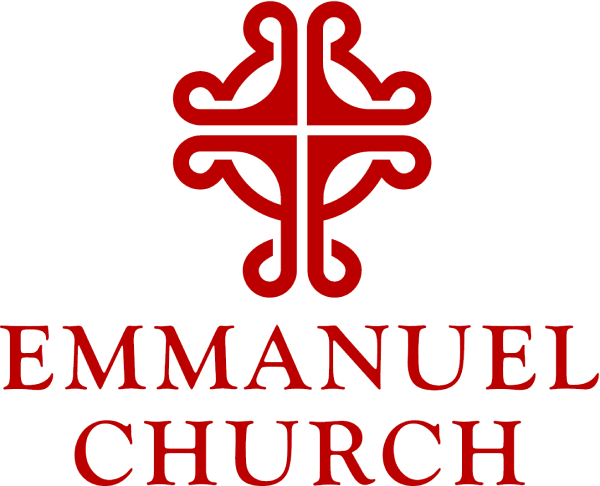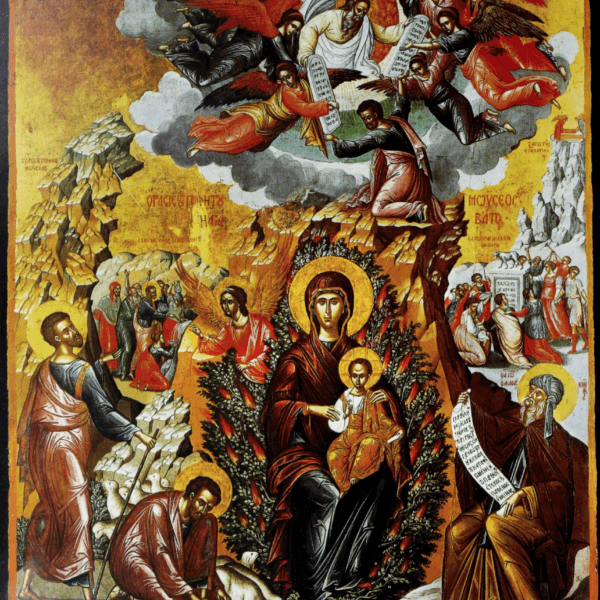
Almighty God, you have poured upon us the new light of your incarnate Word: Grant that this light, enkindled in our hearts, may shine forth in our lives; through Jesus Christ our Lord, who lives and reigns with you, in the unity of the Holy Spirit, one God, now and for ever. Amen.
In the beginning was the Word
The first words of John’s gospel have to be some of the most beautiful poetry anywhere, no matter what the language. Even if you’re not a lover of language, the sheer immensity of the idea just has to knock you back. John’s gospel was originally written in Greek. Word — from the phrase In the beginning was the Word — comes to us from the Greek word Logos. Philosopher/blogger Justin Taylor explains that in ancient Greek, Logos has many meanings, but none of those meanings points directly to the notion of a collection of written letters or spoken sounds that stands for an object or an action — or the relationship between them — like our English Word.
Instead, the biblical Greek LOGOS meant something way bigger than that. LOGOS referred to the power of reason, the natural order of things, and the principle of relation and harmony, which exists both within the natural fabric of the universe and within the human mind. The idea of LOGOS refers to the underlying order of the universe, the blueprint on which all creation is based. In short, LOGOS refers to the mind and order of God. The author of John’s gospel is saying that in the beginning with God was NOT a human or fleshly man but a harmony and natural order of everything.
Mind-bending Translation
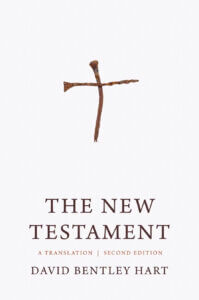 In the Fall of 2018, renowned scholar David Bentley Hart published what a reviewer in The Atlantic called a mind-bending translation of the New Testament. Hart called the translation of LOGOS as the Word “a curiously bland and impenetrable designation for the heady concept expressed in the original Greek of the Gospels as Logos,” suggesting that Word is more usefully translated in our context as the creative energy or activity of God.
In the Fall of 2018, renowned scholar David Bentley Hart published what a reviewer in The Atlantic called a mind-bending translation of the New Testament. Hart called the translation of LOGOS as the Word “a curiously bland and impenetrable designation for the heady concept expressed in the original Greek of the Gospels as Logos,” suggesting that Word is more usefully translated in our context as the creative energy or activity of God.
And the beautiful poetry of John’s gospel’s first words is John’s gospel’s way of expressing God’s presence on earth in Jesus, God incarnate. Matthew’s gospel introduces us to Jesus by telling us who his ancestors are. Mark’s gospel gets straight to what Jesus does with the excited announcement “The good news of Jesus Christ the Son of God,” moving directly to Jesus’ earthly ministry. Luke’s gospel begins with the birth narrative we read Christmas Eve, about Mary and Joseph’s long trek to Bethlehem to be counted for the census.
But John’s gospel is different. Instead of focusing on Jesus’ arrival as God incarnate in the form of a human baby, John’s gospel starts with Jesus’ origin: with God and in God. Jesus is the creative energy or activity of God. Jesus was in the beginning with God and is God. John’s gospel turns our gaze from our own place on earth, and our own context, to God’s creative energy and our place in that energy as people of God. John’s gospel fully embraces the mystery of divinity — a mystery that is not easy to communicate, express, or explain. But poetry, music, and art can help us to express what is absolutely true, but difficult to say, and even more difficult to understand.
Icons
For example, during the year I lived in Palestine and Israel I saw many Orthodox churches filled with icons — very detailed and elaborate paintings of Jesus, John the Baptist, and other figures of faith. But it took some time and study before I was able to “read” the icons, murals, and frescoes in these 1500 year old churches, and to begin to understand how they worked in faith. What icons do is help us to take in ideas that are bigger than the capacity of human reason. That’s one reason why we don’t say that icons are painted. Instead, they are “written” — or even more accurately — “prayed.”
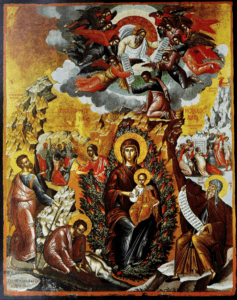 Icon writers, who are faithful artists and theologians, retreat to pray their icons, trying to plumb the mystery of a theological claim, and to express that claim visually. They know that words on their own can’t reach the deepest truths, just like our English translation of LOGOS as “the Word” doesn’t begin to touch the breadth and depth of the theological truth that LOGOS is the creative energy or activity of God. The best way that I can think of to convey this idea now is to describe some ways that Mary is painted in icons in the Holy Lands. You know that Moses experienced God’s presence in the burning bush that was covered with flames and yet not consumed. And you know that the Book of Exodus tells the story of the Ark of the Covenant, that contained the stone tablets of the law that God gave Moses. The Ark, and the stone tablets, represent God’s presence among God’s people.
Icon writers, who are faithful artists and theologians, retreat to pray their icons, trying to plumb the mystery of a theological claim, and to express that claim visually. They know that words on their own can’t reach the deepest truths, just like our English translation of LOGOS as “the Word” doesn’t begin to touch the breadth and depth of the theological truth that LOGOS is the creative energy or activity of God. The best way that I can think of to convey this idea now is to describe some ways that Mary is painted in icons in the Holy Lands. You know that Moses experienced God’s presence in the burning bush that was covered with flames and yet not consumed. And you know that the Book of Exodus tells the story of the Ark of the Covenant, that contained the stone tablets of the law that God gave Moses. The Ark, and the stone tablets, represent God’s presence among God’s people.
It is not uncommon to see Mary painted in an Orthodox or Roman Catholic setting in Eastern churches surrounded, or even overlaid, with images of the burning bush and the ark of the covenant. This image expresses the theological claim that Mary mother of God carries God’s presence, just as the ark represents God’s presence among God’s people, and the burning bush represents God’s presence before Moses. An image at the entrance of a monastery Egypt shows Mary holding Jesus right in the center of the flames of the burning bush. The shape of the image of Mary and Jesus is the same as the bush itself, so it looks like Mary, the God-bearer, and Jesus were a part of the creative energy and activity of God that burned but did not consume the bush. John’s gospel says this with language — with words and poetry — and makes us central to this energy and its creation.
Have you ever tried to read and understand scripture, poetry, art, or great literary fiction in the same way you’d read a recipe, or maybe street signs, or directions for operating a TV remote? It’s all too easy to be too literal and miss the poetry of the idea, or as my senior partner in the law firm used to say, to take the pulse, but miss the heartbeat. When we try to map a great, big idea over our own more limited lived experience, we make God small — and usually in our own image. Let’s try something different today. Let’s lean in to John’s gospel without the distraction of a word that we usually understand literally — that is the Word of God. Here’s today’s gospel again using David Bentley Hart’s more expansive definition of Logos:
In the beginning was the creative energy of God, and this energy was the very activity of God, and was itself God. All things came into being through from this natural order that is present in both the universe and in the human mind, and without this natural order and God’s activity, not one thing came into being. What God’s energy has brought into being is life, and the life was the light of all people. The light shines in the darkness, and the darkness did not overcome it.
We Are Made by Love for Love
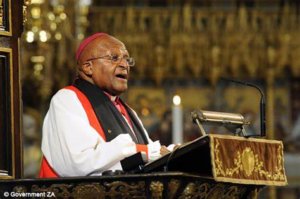 So now: What is John’s gospel telling us about Jesus? That we are made by love for love, or, as Archbishop Desmond Tutu often said and wrote, we are made for goodness. Our very orientation and set point is for good. When we sin, we deviate from the natural order of both the universe and the human mind, and our task is to hit the reset button to restore our thinking, our responses, and our understanding of ourselves and each other to that natural set point. This is what we do in worship, as we flex and strengthen our connection to that natural order that is in both the universe and the human mind.
So now: What is John’s gospel telling us about Jesus? That we are made by love for love, or, as Archbishop Desmond Tutu often said and wrote, we are made for goodness. Our very orientation and set point is for good. When we sin, we deviate from the natural order of both the universe and the human mind, and our task is to hit the reset button to restore our thinking, our responses, and our understanding of ourselves and each other to that natural set point. This is what we do in worship, as we flex and strengthen our connection to that natural order that is in both the universe and the human mind.
Matthew’s genealogy connecting Jesus to our mothers and fathers in the faith all the way down to us, Luke’s description of Jesus’ humble birth, Mark’s breathless announcement of Jesus’ good news, and John’s poetry of God’s light and energy of love that is always around us are all ways of describing what we perceive but can’t quite grasp or explain. But we can see God’s activity in the world in our lives and in our community every day.
Just look for the marvelous things God does:
- The new altar and furniture made from our well-loved pews.
- All the music, the labyrinth, and the dancing that happens in that new space.
- The altar installations in the chapel, and the new linens and Sarum blue vestments.
- Our beautiful home — Emmanuel Church — sheltering and housing our lives together, now heated and cooled with a new HVAC system, and welcoming all with the Community Bridge.
- Our Emmanuel, Newport Classical, Salve, Greenwich, New York, Exeter, Navy, Newport, Middletown, Portsmouth, Kasulu, and Jerusalem family, growing together, taking care of each other, and building community in this place.
As John’s gospel says, what has come into being through Jesus is life, and the life was the light of all people. The light shines in the darkness, and the darkness did not overcome it. If you wonder how to describe God, just look at God’s love in community. The power of this love is amazing. Amen
